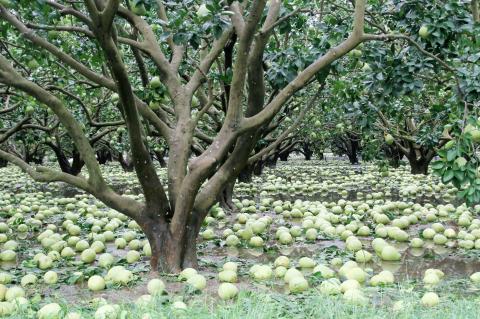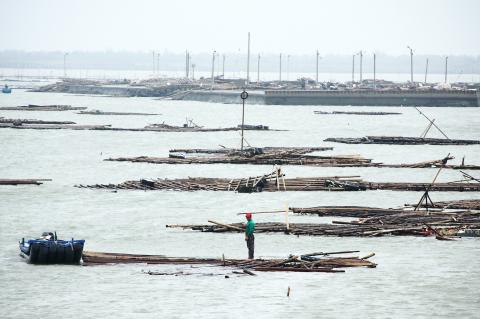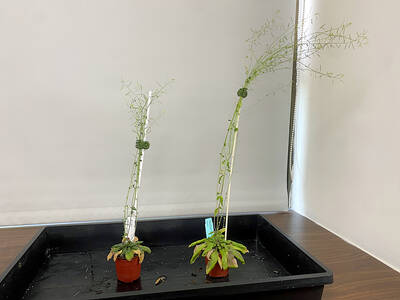The estimate of the nation’s agricultural losses caused by Typhoon Soudelor had risen to NT$600 million (US$18.9 million) as of 6pm yesterday, with Hualien County the hardest hit, the Council of Agriculture said yesterday.
Agricultural losses in Hualien were estimated at NT$134 million, followed by Tainan at NT$124 million, Kaohsiung at NT$79.1 million, Taoyuan at NT$47 million and Pingtung County at NT$44 million.
The estimate of the damage caused by the typhoon is likely to continue to increase in coming days, the council said.

Photo: CNA
Bananas were the hardest-hit crop, suffering losses of NT$125 million, with pomeloes, taros, bamboo shoots and Chinese leeks, also known as kow choi (jiucai, 韭菜), also affected by the storm.
Output from Changhua County’s Sijhou Township (溪州), considered the nation’s largest guava producing area, is not expected to resume for at least three to four months, according to local farmers.
Prior to Soudelor making landfall, the Changhua area was buffeted by foehn winds for an entire night, causing pollinated flowers and immature fruit in more than 500 hectares of guava farms to be “roasted,” local farmer Chang Lung-tan (張龍潭) said, adding that after Soudelor turned southward, the winds whipped the dried fruit and flowers from the trees.

Photo: Lin I-chang, Taipei Times
The majority of Tainan’s agricultural losses were pomeloes, the Tainan City Government said.
Tainan Mayor William Lai (賴清德) visited Madou (麻豆) to assess the damage, promising to appeal on the farmers’ behalf for council subsidies according to the Agricultural Natural Disaster Relief Regulations (農業天然災害救助辦法), adding that he would also ask if the army is willing to provide personnel to help farmers more quickly clear out their orchards.
Yunlin County Legislator Chang Chia-chun (張嘉郡) visited the county’s affected areas and received complaints from “new farmers” that their greenhouses, which many had built for NT$3 million on bank loans of NT$2 million, were damaged.
Chang said that she has asked the Agriculture and Food Agency to schedule inspections of damage caused by the typhoon, and that she would also ask the central government to fund exclusive subsidies for these farmers.
The council yesterday estimated that livestock, aquaculture and forestry losses, as well as losses suffered by animal husbandry operations, totaled NT$84.7 million.
Strong winds along the Chiayi County coast devastated the region’s prized oyster and clam farms, which suffered losses that might be the most severe in two decades.
The Dongshih (東石) and Pudai (布袋) townships together produce an estimated 9,500 tonnes of oysters and clams per year in an industry valued at NT$2.15 billion, oyster farmer Tsai Mao-chi (蔡茂記) said.
Preliminary estimates place losses at nearly NT$100 million, Tsai said, adding that oyster and clam production will be halved in the second half of the year and the losses will also directly affect resellers and restaurants.
The industry will take more than half a year, maybe even up until March next year, to recover from its losses, Tsai said.
Chiayi official Lee Chien-lin (李建霖) said that between 8,000 and 9,000 floating oyster farms were damaged by the storm, but the local fisheries association still needs to determine the exact figure.
One oyster farmer, surnamed Chen (陳), said that his losses from Soudelor were worse than from Typhoon Morakot, as he lost 90 oyster farms, each costing NT$60,000 in overheads. Along with losses from oysters swept out to sea, Chen said he has lost more than NT$6 million.
Additional reporting by Liu Wan-chun and Yen Hung-chun

Taiwanese scientists have engineered plants that can capture about 50 percent more carbon dioxide and produce more than twice as many seeds as unmodified plants, a breakthrough they hope could one day help mitigate global warming and grow more food staples such as rice. If applied to major food crops, the new system could cut carbon emissions and raise yields “without additional equipment or labor costs,” Academia Sinica researcher and lead author the study Lu Kuan-jen (呂冠箴) said. Academia Sinica president James Liao (廖俊智) said that as humans emit 9.6 billion tonnes of carbon dioxide compared with the 220 billion tonnes absorbed

The Taipei Mass Rapid Transit (MRT) Wanda-Zhonghe Line is 81.7 percent complete, with public opening targeted for the end of 2027, New Taipei City Mayor Hou You-yi (侯友宜) said today. Surrounding roads are to be open to the public by the end of next year, Hou said during an inspection of construction progress. The 9.5km line, featuring nine underground stations and one depot, is expected to connect Chiang Kai-shek Memorial Hall Station to Chukuang Station in New Taipei City’s Jhonghe District (中和). All 18 tunnels for the line are complete, while the main structures of the stations and depot are mostly finished, he

Taipei is to implement widespread road closures around Taipei 101 on Friday to make way for large crowds during the Double Ten National Day celebration, the Taipei Department of Transportation said. A four-minute fireworks display is to be launched from the skyscraper, along with a performance by 500 drones flying in formation above the nearby Nanshan A21 site, starting at 10pm. Vehicle restrictions would occur in phases, they said. From 5pm to 9pm, inner lanes of Songshou Road between Taipei City Hall and Taipei 101 are to be closed, with only the outer lanes remaining open. Between 9pm and 9:40pm, the section is

China’s plan to deploy a new hypersonic ballistic missile at a Chinese People’s Liberation Army Rocket Force (PLARF) base near Taiwan likely targets US airbases and ships in the western Pacific, but it would also present new threats to Taiwan, defense experts said. The New York Times — citing a US Department of Defense report from last year on China’s military power — on Monday reported in an article titled “The missiles threatening Taiwan” that China has stockpiled 3,500 missiles, 1.5 times more than four years earlier. Although it is unclear how many of those missiles were targeting Taiwan, the newspaper reported